Isle of Dogs
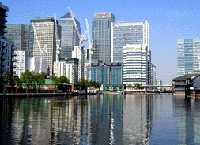
CANARY WHARF & WEST INDIA DOCKS.
Isle of Dogs |  |
| Until about 1800, the Isle of Dogs was marshy agricultural area often referred to as Stepney Marshes. It was known for its lush pastures. There is a legend saying that it got its name from the Tudor royal hunting dogs which were kept here. But the same story is told about The Spotted Dog pub at Forest Gate and that was much nearer Epping Forest where the hunting took place. Once the docks were built c. 1800, the waterways of the docks cut off the southern part making it truly an island. (See Foundation Stone of the West India Docks for more details.) Because of bomb damage in World War 2 and the introduction of larger container ships, the docks gradually closed. In the 1980's, a Docklands Development Board was set up and work began at Canary Wharf. (For the origin of the name Canary Wharf see under Jubilee Place Mosaics.) The area has been transformed into a high rise business centre. The old docks have been reduced in area to allow for more building space, but large areas of water remain to give impressive vistas of the modern buildings. Many traces of the old docks and their machinery still survive and some are listed here and on the pages Millwall and Poplar. There is also a rich display of modern art. |
 TO READ NAME ~ CLICK FOR PHOTO & EXPLANATION.
TO READ NAME ~ CLICK FOR PHOTO & EXPLANATION.CONTENTS |
||
| 1. Ancient Lights. | 2. Bench. | 3. "The Big Blue." |
| 4. Bridge House. | 5. Buoys. | 6. "The Cat & Canary" |
| 7. "Centauro" | 8. "Centurione 1." | 9. Michael von Clemm. |
| 10. "Columbus Screen." | 11. Columbus Courtyard Fountain. | 12. "Couple on Seat." |
| 13. Dockmaster's House. | 14. "Figurehead for Docklands." | 15. Floor (Below ground) |
| 16. Glass Ventilation Towers. | 17. "Globe" | 18. Guard House |
| 19. The Gun. | 20. The Hart of Hertsmere Rd. | 21. "It Takes Two" |
| 22. Jubilee Pl. Mosaics. (Below) | 23. "The Leap." | 24. Lion. |
| 25. Limehouse Link Tunnel | 26. The Oldest Londoner. | 27. "The Man With Open Arms". |
| 28. "Original Form." | 29. "Robert Milligan." | 30. Port of London Authority. |
| 31. Railings. | 32. "Returning to Embrace." | 33. "St Peter." |
| 34. Sculptured Gate. | 35. "On Strange & Distant Islands" | 36. "Testa Adormentata." |
| 37. "Traffic Light Tree". | 38. "Two Men on a Bench." | 39. "Vanishing Point." |
| 40. West India Dock Arch. | 41. West India Dock Warehouses. | 42. Willoughby Passage Gates |
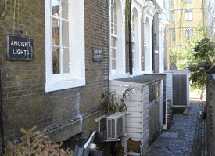 |
Ancient Lights. | |
By the side of the Dockmaster's House, just off Hertsmere Road. There are notices on the wall claiming "Ancient Lights" Next to the building is an old cobbled street. The owners are clearly worried that some tall building might be erected which would cut down the light coming into their windows, which have been free of obstruction for many years. An old law states that provided that that someone has had unobstructed light for a reasonably long period, he can claim this as a legal right in future years. (See No. 1. on the MAP )
|
||
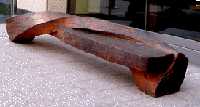 |
Sculptured Bench | |
Now in the open area by Upper Bank Street. One of two interesting sculptural benches in this area. (See No. 2. on the MAP ) |
||
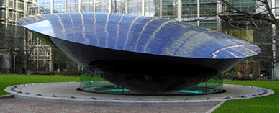 |
The Big Blue or Skylight. | |
Situated in Canada Square, this was designed both as the skylight of the shopping mall below and as a sculptural image above ground, especially when the blue lights around it reflect off the curved under-surface. Many of the locals refer to it as the "Flying Saucer". (See No. 3. on the MAP )
Designer: Ron Arad. 1998. |
||
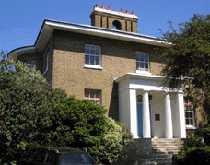 |
Bridge House. | |
Near the lock at the entrance to the West India Dock. Built for the Supervisor of the dock by John Rennie in 1819. This Grade 2 listed house with a distinctive chimney is now occupied by the London Federation of Boys Clubs. (See No. 4. on the MAP ) |
||
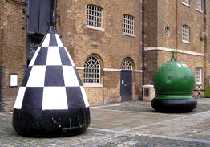 |
Buoys. | |
West India Docks, outside the Docklands Museum. (The Museum is not listed here because they make an admission charge.) The buoys are on the quayside and can be seen by passers by. The spherical green buoy was used for marking the sites of wrecks and the black and white chequered buoy was used to mark navigational channels and was usually marked on top with the depth of the channel. See No. 5. on the MAP ) |
||
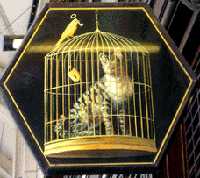 |
"The Cat and Canary." | |
Pub on the corner at Wren's Landing. This amusing pub sign is one of a series of four paintings hanging outside the pub. This one shows an disgruntled cat in a padlocked birdcage with a chirpy canary perched on top with the key in its beak. (See No. 6. on the MAP ) |
||
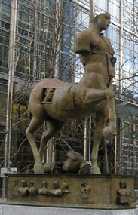 |
"Centauro." | |
In the open area by Upper Bank Street. (See No. 7. on the MAP ) Artist: Igor Mitoraj. (See also by the same artist "Centurione 1" and "Testa Adormentata". ) |
||
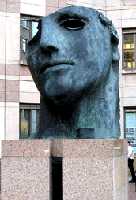 |
"Centurione 1." | |
Columbus Courtyard. Part of a large bronze head set over the water feature in the centre of the square. (See No. 8. on the MAP ) Sculptor: Igor Mitoraj. Date c. 2000. (See also by the same artist "Centauro" and "Testa Adormentata". ) |
||
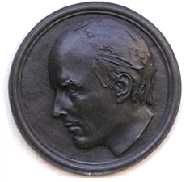 |
Michael von Clemm. | |
Cabot Square. Michael von Clemm (1935-1997), a financier, was one of the moving spirits behind the Docklands development project. The square is named after John Cabot (c. 1425 � 1500) and his son Sebastian Cabot (1474 - 1557), Italian-born navigators and explorers. In the reign of Henry VII, John sailed to Nova Scotia, which he claimed for England. Sebastian accompanied his father in a later voyage searching for a northerly passage to Asia. (See No. 9. on the MAP ) Sculptor: Gerald Laing. Date: 1998. |
||
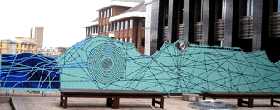 |
"Columbus Screen" | |
Specially designed fence made of decorative glass and other materials to mark the border of Columbus Courtyard and to prevent pedestrians from a dangerous drop onto the busy roadway below. There is an explanatory notice designed for Lilliputian visitors which tells how the artist was inspired by a Mappa Mundi (World Map) which showed navigational routes not long after the time of Christopher Columbus, while to the left of the design is shown the concept at that time of a world surrounded by the celestial spheres. Note also the designs in the lens in the central eye. (See No. 10. on the MAP ) Artist: Wendy Ramshaw. Date: 2000. |
||
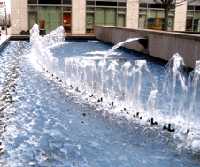 |
Columbus Courtyard Fountain. | |
In this courtyard there is a large fountain with many jets of water arranged in an impressive layout. The same designer was also responsible for the fountain system in Cabot Square. (For Columbus courtyard see No. 11. on the MAP ) Designer: Richard Chaix. |
||
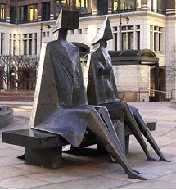 |
Couple on Seat. | |
Cabot Square. Bronze statue. For the name of Cabot see Michael von Clemm. (For Sculpture, see No. 12. on the MAP ) Sculptress: Lynn Chadwick. Date: 2000. |
||
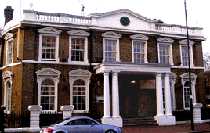 |
"Dockmaster's House" | |
In a small cul-de-sac off Hertsmere Road. Now occupied by an Indian restaurant. Built in 1807, it was used by an Excise Officer, next as an inn called the Jamaica Tavern and later as a Dock Manager's office, but has never been the house of a Dockmaster. For the round crest on the front of the building see Port of London Authority. (See No. 13. on the MAP ) |
||
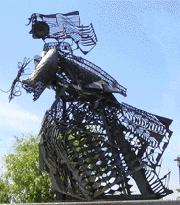 |
"Figurehead For Docklands." | |
Northeast corner of Poplar Dock, just off Trafalgar Way. In the shape of a female similar to the solid wooden figureheads of the old sailing ships, but this is made of metal pieces which are clearly not solid. The artist seems to have used industrial waste. The patterns of the clothing come from sheet metal with repetitive shapes pressed out. The figure appears to be holding the head of a chimney sweep's flu brush. (See No. 14. on the MAP ) Artist: Anna Bisset, 1997. |
||
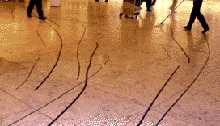 |
Floor | |
Canada Square, the lowest floor of the shopping area. The lines are intended to convey the idea of flowing water. Presumably referring to the stream of people walking along here. (See No. 15. on the MAP ) Artist: Antoni Malinowski. |
||
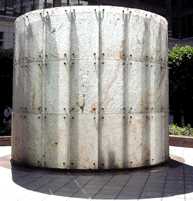 |
Glass Ventilation Towers. | |
Cabot Square. Four large translucent glass ventilation Towers or funnels, which are internally illuminated at night. (See No. 16. on the MAP ) Artist: Jeff Bell. |
||
 |
"Globe" | |
Westferry Road almost opposite the Limehouse Link tunnel. This is a series of clocks registering the times in major cities throughout the world. (See No. 17. on the MAP ) Artist: Richard Wentworth, Date (?) Time: Take your pick. |
||
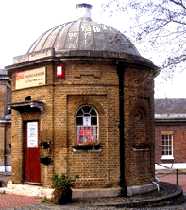 |
Guard House. | |
The lone survivor of two guard houses of 1803, which were once situated next to the drawbridge over the moat round the dock walls. This building was used for storing arms and the other for holding prisoners taken by the guard stationed at the wall of West India Docks. This armoury is now occupied by a newsagent who has put an illuminated advertising sign over the door. (See No. 18. on the MAP ) |
||
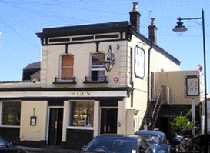 |
The Gun. | |
27 Coldharbour. This is an old riverside pub, parts of which may date from the early 17th century, but mostly from the early 1800s. There are two interesting houses further up the street. No. 1 was built for the dockmaster and No. 3 is called Nelson House. Local folklore links this with Nelson and Lady Hamilton, but it was probably built after his death. (See No. 19. on the MAP ) |
||
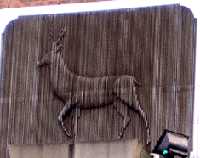 | The Hart of Hertsmere Road. | |
Hertsmere House on Hertsmere Road, opposite Cannon Drive. In Mediaeval English "hart" was spelt hert or herte. This figure is formed shaping the edges of a number thin sheets. As there is a space between each of the sheets there is a lightness to the outline of the figure. (See No. 20. on the MAP ) |
||
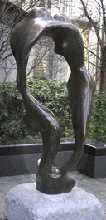 |
"It Takes Two" | |
Canada Square. Bronze statue. (See No. 21. on the MAP ) Sculptor: Bob Allen. Date: 2002. |
||
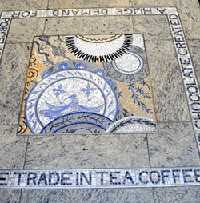 |
Jubilee Place Mosaics. | |
A series of mosaics below ground level on the lower floor of the Jubilee Place Shopping Mall. The theme of the mosaics is the variety of the goods that used to come through the docks previously on this site. The ten subjects shown are: Beaver skins, Carpets, Coffee chocolate & tea (illustrated here), Feathers, Ropes, Sea shells, Snake skins, Textiles, Tomatoes, Tortoise Shell and Wines & Spirits. From one of these we learn that Canary Wharf got it's name from the tomatoes imported from the Canary Islands. (See No. 22. on the MAP ) Designer and Maker: Emma Biggs. |
||
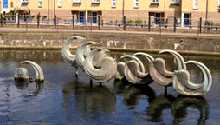 |
"The Leap." | |
Just off Manchester Road, in the southern part of Blackwall Basin by Lovegrove Walk. This shows eight dolphins, which originally were fountains. (See No. 23. on the MAP ) Sculptor: Franta Belsky Date: c. 1982. |
||
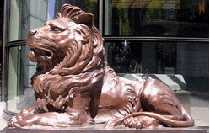 |
Lion. | |
Canada Square. One of two guarding the entrance to the HSBC building. An inscription states that these are exact copies of two statues which were made for the Hong Kong offices of the bank. (See No. 24. on the MAP ) Original sculptor: W.W. Wagstaff. Date: 1935. |
||
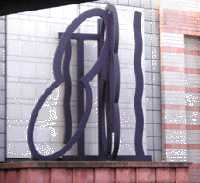 |
Limehouse Link Tunnel. | |
Large abstract sculpture is situated over the northbound entrance of the Limehouse Link Tunnel on the North Quay Services Building. (See No. 25. on the MAP ) Sculptor: Nigel Hall. |
||
 |
The Oldest Londoner. | |
The earliest person known to have lived in the London area was found in Yabsley Street. Archaeologists will tell you that a body of a young person who lived about 4000 BCE was discovered here. There is nothing to be seen. One can stop and wonder what he was doing so near to the river. (See No. 26. on the MAP ) |
||
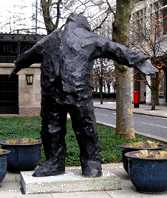 |
"Man With Open Arms" | |
Bronze statue in West India Avenue. This sturdy figure with his head back appears to be appealing to heaven. If he had placed facing in the opposite direction, he would have been marvelling at the height of Canary Wharf Tower. (See No. 27. on the MAP )
Sculptor: Giles Penny. Date: 1995. (see also "Two Men on a Bench" by the same artist.) |
||
 |
"Original Form" | |
By the side of West India Dock, almost below West India DLR station. This wooden sculpture is made of Douglas Fir. (See No. 28. on the MAP ) Sculptor: Keith Rand. Date: 1999. |
||
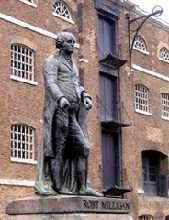 |
Robert Milligan | |
West India Docks, outside the Docklands Museum. Robert Milligan (1745-1809) was one of the leading figures behind the building of the West India Docks. He is mentioned on the large stone inscription on the western end of this block as being Deputy Chairman of the West India Dock Company. Of those who opened the dock in 1802 he was rated fourth after the Lord Chancellor, the prime minister (William Pitt) and the Chairman of the West India Dock Company. At the base of the statue there is a bas relief showing Britannia and a cornucopia in the foreground with sailing ship behind. A woman and children who are perhaps meant to be West Indian are also shown. (See No. 29. on the MAP ) Sculptor: Richard Westmacott. 1813.
|
||
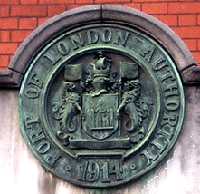 |
Port of London Authority. | |
This badge can be found on the front of Cannon House in Hertsmere Road. The building was previously the police Station of the Dock Police. By the end of the 19th century, the rivalry between the various docks and dock companies was found to be detrimental to trade. So in 1909, the PLA was formed as a public body, and made responsible for running the Docks and all the shipping on the Thames. Another badge with a later date can be seen on the "Dockmaster's House". (For Cannon House, see No. 30. on the MAP ) |
||
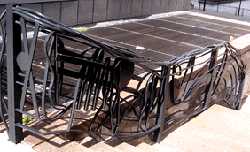 | Railings | |
Wren Landing off Cabot Square, Railings and banisters designed as a sculptured artwork in wrought iron. (See No. 31. on the MAP ) Designer: Bruce McLean (see also by the same artist Eye-1 ) |
||
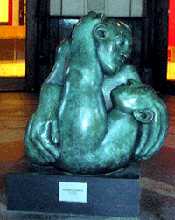 | "Returning to Embrace" | |
Bronze statue at the entrance to 10 Cabot Square. On the name Cabot see Michael Von Clemm (For sculpture, see No. 32. on the MAP ) Sculptor: Jon Buck. 2000 . |
||
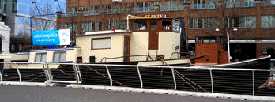 | "St Peter" | |
London's floating church, moored in West India Dock opposite the Docklands Museum. This could be very convenient but a little hazardous church for baptisms. (See No. 33. on the MAP ) |
||
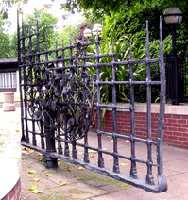 | Sculptured Gate | |
Westferry Circus. The two gates to the central garden have been specially created out of wrought iron. Instead of hinging at one end, they pivot about a point about one third the way along. The gates have a rustic theme and symbolize the seasons. (See No. 34. on the MAP ) Designer: Guiseppe Lund. |
||
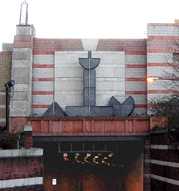 | "On Strange and Distant Islands." | |
Situated over the Limehouse Link road tunnel, which takes traffic to the Highway. This sculpture is made of Kilkenny limestone. In order to build this tunnel it was necessary to relocate 556 households. (See No. 35. for pointer to it's position just off the MAP ) Designer: Michael Kenny. |
||
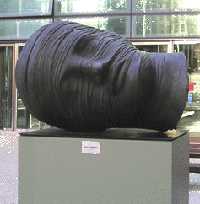 | "Testa Adormentata" | |
Outside 40 Jubilee Place. A large bronze head depicted swathed in bandages. (See No. 36. on the MAP ) Sculptor: Igor Mitoraj, Date: 1983. (See also " Centurione 1 " and "Centauro" by the same artist.) |
||
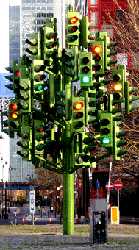 | "Traffic Light Tree" | |
On the traffic Island of Heron Quays Roundabout. This tree made of traffic lights changes the lights in a random order. It could be called "a Driver's nightmare", but motorists have learned to ignore it's confusing signals. (See No. 37. on the MAP ) Designer: Pierre Vivant. Date: 1997. |
||
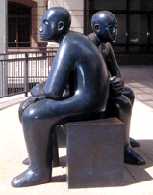 | "Two Men on a Bench." | |
Just south of Cabot Square, at the bottom of Cubitt Steps by the side of Mackenzie Walk. Because they are not facing each other, one wonders whether these two characters know each other or not. This is probably not the correct title for the work, which does not appear to have an accompanying notice or description. (See No. 38. on the MAP ) Sculptor: Giles Penny. (See also by the same artist "Man With Open Arms".) |
||
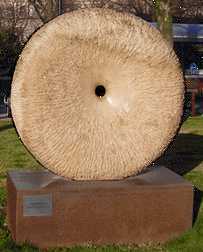 | "Vanishing Point" | |
On the southern side of Westferry Circus. Made in Derbyshire limestone on a steel base. (See No. 39. on the MAP ) Sculptor: Jay Battle. Date: 1999. |
||
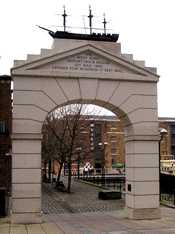 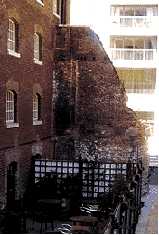 | West India Dock Arch. | |
West India Dock. This best explained by the two inscriptions which have been placed on it:
Artist: Leo Stevenson. The right hand picture shows a small section of the dock wall attached to the eastern end of the row of warehouses backing on to Hertsmere Road. This piece of wall is attached to the rear wall of what is now Brown's Restaurant. Note the wall is nearly three floors high - that is c. 30 foot or 10 metres. (For the section of wall see No. 43. on the MAP ) |
||
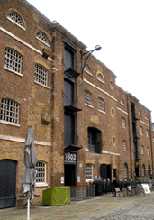 | West India Dock Warehouses. | |
Along the side of the dock there is a row of old warehouses which date back to 1802. They have, of course, been renovated since that date but most of their original features have been preserved. The pulleys used for raising and lowering the heavy goods can still be seen on arms which swing out from the buildings. The large doors on each floor, through which the goods were brought in, are also there. The imported goods were transported from the docks in various ways. Much was loaded onto Thames barges and some left by horse and cart. Later a spur of the railway was laid to provide goods transport to both the West India and East India docks For the original commemorative inscription look on western wall of the row. The latter is a very large inscribed stone shown at the bottom of this page. (For the warehouses see No. 41. on the MAP ) |
||
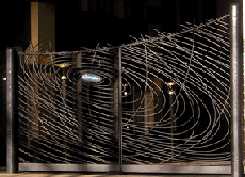 | Willoughby Passage Gates | |
Willoughby Passage off West India Avenue. This is a swirling design which orbits round a shining blue nucleus. This passage is named after Sir Hugh Willoughby, navigator and explorer who collaborated with Sebastian Cabot in searching for a northerly route to Asia. In 1553, he set out and got as far as Lapland, but was forced to spend the winter there. Willoughby and his crew did not survive that winter. (See No. 42. on the MAP See also the Willoughby Memorial ) Designer Kate Hackney. Date: 2000. |
||
The Founding of West India Docks | 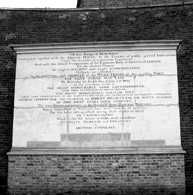 | |
| The early history of West India Docks is displayed for all to see on this commemorative stone still standing after more than two centuries. The stone is in Hertsmere Road on the Dock Wall which is the side wall of Lloyds No. 1 Bar and Ledger Building. It shows that importers were dissatisfied by the delays and losses from stealing when ships were unloaded on the Thames. It is also an interesting example official language 200 years ago. | ||
| ||
| A statue of Robert Milligan is shown on this page. Sometimes the 's' is shown as like the 'f', the occurrences of this are shown above, but these should not have a cross stroke as they do on your screen. (For position of this inscription see No. 44. on the MAP ) | ||
|| Beckton || Bethnal Green || Blackwall || Bow || Bromley-by-Bow || Canning Town || Chingford || Cubit Town || Custom House || East Ham || East India Dock || Forest Gate || Higham's Park || Leyton || Leytonstone || Limehouse || Little Ilford || Manor Park || Mile End || Millwall || North Woolwich || Plaistow || Plashet || Poplar || St George's || St Katharine Dock || Shadwell || Shoreditch || Silvertown || Snaresbrook || Spitalfields || Stepney || Stratford || Upton || Walthamstow East || Walthamstow Village || Walthamstow West || Wanstead || Wapping || Whitechapel || Woodford || |